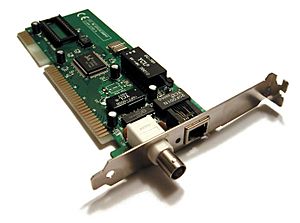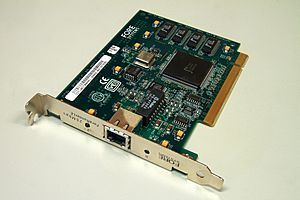Network card facts for kids
A Network Interface Card (often called a NIC or network card) is a special electronic part that helps your computer connect to a computer network. Think of it as a translator that lets your computer talk to other computers or the internet. Most of the time, this network is a LAN, which is a small network like the one in your home or school.
Network cards are a type of computer hardware. In many modern computers, especially laptops and newer desktops, the network card is built right into the computer's main circuit board, called the motherboard. This means you don't usually see it as a separate piece. However, older computers or some specialized ones might have network cards that you can add or remove.
The main job of a network card is to let your computer send and receive data over a network. To do this, it uses special rules called protocols. Today, most network cards use a common protocol called Ethernet.
Contents
Different Types of Network Cards
Network cards come in various shapes and sizes, known as form factors. These have changed a lot over the years as computers have developed.
- Older Desktop Cards: In the 1990s, network cards for desktop computers were quite large. You had to open your computer's case to put them inside. They used a standard called Industry Standard Architecture (ISA).
- Modern Desktop Cards: Newer desktop computers use smaller cards that fit into slots called Peripheral Component Interconnect (PCI) or PCI Express. These are usually installed by the computer maker. You might still find these if your computer's motherboard doesn't have a built-in Ethernet port.
- Laptop Cards: For laptops and other portable devices, there were once credit card-sized Ethernet cards called Personal Computer Memory Card International Association (PCMCIA) cards. These slid into slots on the side of the laptop. However, most modern laptops now have Wi-Fi built-in and don't use these cards anymore.
- USB Adapters: Some network cards look like small boxes and connect to your computer using a USB port. These are handy if your computer doesn't have a built-in Ethernet port or if you need an extra one. They are also often used with video game consoles.
How Fast Are Network Cards?
Network cards can send and receive data at different speeds. This speed depends on the Ethernet standard they support.
- Early Ethernet: The very first Ethernet cards could only handle speeds up to 10 Mbps (megabits per second).
- Fast Ethernet: Most modern network cards support Fast Ethernet, which can reach speeds of 100 Mbps. This is much quicker for downloading and streaming.
- Gigabit Ethernet: An increasing number of network cards now offer Gigabit Ethernet. This is super fast, reaching 1 Gbps (1000 Mbps). This speed is great for very fast internet connections or moving large files around a network.
It's important to know that a regular Ethernet card doesn't directly connect to Wi-Fi wireless networks. However, many home internet routers have both Ethernet ports (for cables) and Wi-Fi technology. This means your computer can connect to the router with a cable using its Ethernet card, and the router can then talk to your Wi-Fi devices wirelessly.
The Future of Network Cards
For a long time, network cards were essential because cables were the main way to connect to networks. Ethernet connections are still very reliable, often more so than wireless connections. That's why they are still popular for desktop computers and other devices that don't move around much.
However, mobile devices like laptops and tablets have mostly switched from using Ethernet cables to relying on Wi-Fi. As Wi-Fi becomes available in more places like schools, coffee shops, and public areas, the need for wired Ethernet connections has decreased for people who travel a lot. This means that while Ethernet cards are still important, Wi-Fi has become the more common way for many devices to connect to the internet.
Images for kids
-
12 early ISA 8 bit and 16 bit PC network cards. The lower right-most card is an early wireless network card, and the central card with partial beige plastic cover is a PSTN modem.
-
Intel 82574L Gigabit Ethernet NIC, a PCI Express ×1 card, which provides two hardware receive queues
See also
 In Spanish: Tarjeta de red para niños
In Spanish: Tarjeta de red para niños






